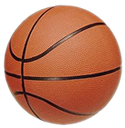Youth Basketball Offense Basics
There’s so much to learn about the Youth Basketball Offense that it would be impossible to cover all the info on one page. The coaching tips, basic basketball information, and youth basketball offense fundamentals shown below will give you a better understanding and direction with regards to coaching and / or playing basketball offense.
Check our our new download publications Zone Offenses for Youth Basketball and Motion Offenses for Youth Basketball
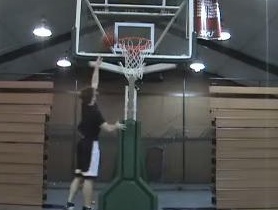 |
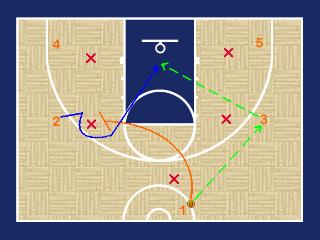 |
 |
This page will cover just some Youth Basketball Offense Basics. There are other pages on this site that cover more advanced information regarding offenses.
Definition of Basketball Offense / Plays:
The team that has possession of the basketball and is attempting to score points. Types of offenses include: Zone Offenses, Motion Offenses, Press Breakers, Transition (Fast Break), and Inbounds plays (all these types of offenses have different names for easy identification).
An Offensive “Play” is a “planned” pattern taught to the players to keep the players “organized” on the court – Plays give the team a more structured opportunity to score a basket vs. the type of defense they are facing.
Types of Offenses:
There are many types of offenses, and each have several variations to them (there is not just one type of zone offense – there are many). Lets take a closer look at each of the main types…
1. Zone Offense: A Zone Offense is a type of offense that is run within the half court area vs. a zone defense. The players running a zone offense in the diagram below are denoted by the numbers 1, 2, 3, 4, and 5. The main zone defenses are the 2-3, 1-2-2, 1-3-1, 2-1-2, and the 3-2. There are also types of zone defenses called “Junk” defenses.

Zone Offenses for Youth Basketball
2. Motion Offense: A Motion Offense is the type of basketball offense used vs. an opponent who is playing Man-to-Man Defense. A motion offense utilizes screens, cutting, and lots of motion. Sometimes coaches will use a motion offense vs. a zone defense just to create more movement (rarely used, but sometimes a good change of pace when needed).
Motion Offenses for Youth Basketball
3. Press Breaking: Is a type of basketball offense / offensive set that a team uses when their opponent is running a “Full Court Press” defense. The pass is the fastest way for any team to break the press. Games can end quickly if you are not ready to handle pressure defense with a good press breaker play.
More information on Press Breakers
The Fast Break is Considered an Offense!
4. Transition Offense (Fast Break): Transition Basketball Offense is when the defense “converts” into offense. Ex: when the defense gets the rebound, they are now on offense. Transition offense refers to the fast break – where the defense rebounds or steals the ball, outlets the ball to a teammate, and the ball gets up the court quickly, with the possession ending in a possible score (all before the other team gets there to play defense). Many games are won quickly with the fast break!
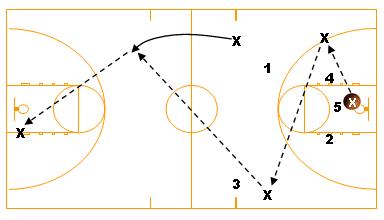
A diagram showing how a fast break works – The X’s are defenders turned offensive players after the rebound.
5. In-bounds Play: An In-bounds play (also called “out of bounds” play) is the best way to put your offense in a good position for a quick score or to get the ball in safely (without the defense stealing the ball). Look at the inbounds play as just a quick way for your team to get an easy basket…
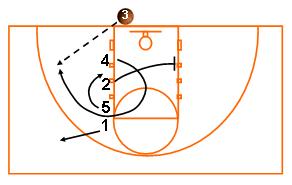
More information on Inbounds Plays
Positions Used in a Basketball Offense:
The are several positions used on offense and all have specific responsibilities. Let’s take a look…
The Point Guard
The point guard is usually the best ball handler on the team. Point guards must be able to dribble and “see” what’s happening on the court. The point guard brings the ball up and runs the plays. Also referred to as the “playmaker,” “floor general,” and sometimes as the “quarterback.” Usually numbered as the “1.”

More information on Point Guards
Guards / Shooting Guards
These are the players on a team that are usually the best outside shooters, good ball handlers, fast, and usually the smaller players on the court. A guard must look to score or get the ball in to the post players when the opportunity is there. Usually numbered the “2” (shooting guard) or “3” (guard). The “3” can also be a small forward (see below).
Center (Post Player position)
Refers to the tallest (or largest) player on the team that plays in the middle on defense, and the post area on offense. In youth basketball (the younger age groups) it is common for coaches to use a small “tough” player (in a 5-guard set) instead of a taller less “aggressive” player. Usually called the “Center” and numbered the “5.”
More information on Post Players / Post Play
Forwards (Post Player position)
Usually the taller (but smaller than the center) players on the court, and are usually referred to as Forwards or Small Forwards. Forwards are taller than guards, but usually smaller than the center. A good forward can shoot like a guard, handle the ball, rebound, and also have some post moves like the center. Usually numbered as the “3” (small forward) or “4” (forwards).
The Sixth Man
This references the player that usually comes off the bench first (the first substitute). Besides the starting players, this is often a team’s best player. The sixth man position is a very important one, if fact, at most high schools / colleges / and the NBA, there are special awards for the “sixth man” position.
What does it take to play good Offense?
A great offense is very disciplined, works as a team, demonstrates patience, executes and attacks at the right moment. The saying is that “Defense wins Games” and “Offense wins Championships.”
Not to take anything away from defense, but offensive skills take more time to “master” than defensive skills. Usually size matters on offense – a very small player can’t play in the post, but can shoot a 3-pointer, a tall player may not be able to bring the ball up the court like a smaller point guard, but they can get rebounds. There are going to be dozens of different skills that players will need to be taught individually (according to size and speed). Don’t get me wrong, there are tall players that can shoot 3-pointers and even handle the ball, but that doesn’t happen every day. Coaches have to deal with what they have, evaluate the talent level on your team, and then come up with a plan.
Let’s review some of the fundamental skills used on offense that all players should know, and what coaches should be “drilling” in their practices.
Examples of Offensive Skills used in Basketball:
1. Shooting: There are Lay-Ups, Jump Shots, 3-Point Shots, Bank Shots, Free Throws, and other types of shots just to name a few… A Shooter is a player that shoots the ball. Shooting the ball is a basic “art form” that takes a great amount of practice to perfect. This website has many pages that cover shooting…
More information on the Basics of Shooting
A Shooters Range is basically the distance from the basket where players can make a high percentage of their shots. Players must understand their shooting range and try not to attempt shots from beyond their range. A good rule to use for players shooting range: If a player can make at least 6 out of 10 shots from a spot on the court in practice, then they are allowed to take that shot in a game.
Developing the Right Hand Lay Up - The Steps
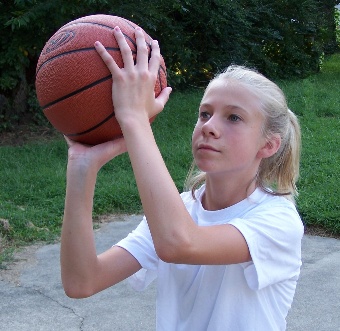
2. Triple Threat: The “Triple Threat” stance is likely the most valuable skill that a coach can teach their players – it is used at all levels of basketball. The Triple Threat Position is a basic offensive position that a player may Shoot, Pass, or Drive to the basket out of.
*Triple Threat basic position = Knees flexed (bent slightly), ball to the side, hands firmly holding the basketball, and always facing the defender (see picture).
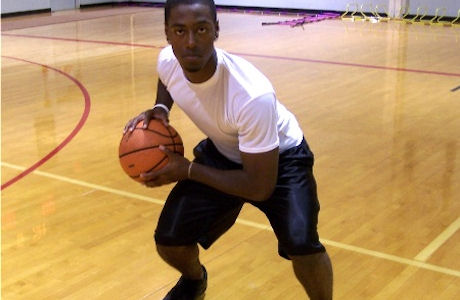
Is Rebounding and Boxing Out part of Offense?
3. Rebounding / Boxing Out: Offensive rebounding is very important to any offense. There’s nothing like a post player rebounding a missed shot and scoring for your team.
A rebound occurs after a missed shot attempt. Usually the missed shot bounces off the backboard or rim (or sometimes doesn’t hit anything at all – which is called an air ball). Players that “box out” will get more rebounds. Offensive players that rebound a missed shot usually get an easy basket (put-back) after the rebound. Any shots taken far from the basket (3-point shot) usually bounce further from the basket (long shot, long rebound).
Boxing Out Basics (Right Side)
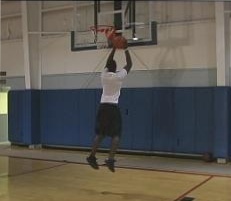
4. Fakes: There are several types of basic “fakes” that are used in basketball – the Pass Fake, Shot Fake, Head Fake, and Ball Fake to name a few.
A fake is a “deceptive” move to “trick” a defender. There are different types of “fakes.” The “pass fake” is very effective and can throw off many defenders if executed correctly. The “shot fake” is a “one on one” move that is just as effective if done correctly. There are also “ball handling” fakes (cross-overs, behind the back dribbling, etc) but these are not usually referred to as “ball handling fakes” just “good moves”.
5. Passing / Catching: There are many types of passes – Chest, Bounce, Overhead, Step Around, Lob, and Backdoor Pass. Each has its own special purpose… All passes must be strong and accurately thrown!
Weave Passing Drill / Basic Half Court
More information on Basic Passing
Ball Handling is Key
6. Ball Handling / Dribbling: There are literally hundreds of ball handling drills available to teach your players. Basic Dribbling, Under the Legs, Behind the Back, Cone Dribbling, Side to Side Dribbling, Dribble and Stop, Crossover, and 2-Ball Dribbling just to name a few…
In a game situation the “ball handler” is usually the player (or players) that can dribble the ball extremely well. The Point guard is usually the best “ball handler” on the team. Even so, all players must learn good ball handling skills! Good ball handlers can dribble the basketball without having to look at the ball, they can see what’s happening on the court (they can see the floor).
Basic Dribble to Half Court and Back

7. Footwork / Hand Speed: Speed, Quickness, Athleticism, Stopping, Pivoting, Sprinting, Post Moves, and Bursting to name a few – all help a player become better on offense. Foot speed and Hand speed are very important skills for players, and coaches must make time on their practice schedule to include drills for this.
The Jump Stop is one of the most important footwork skills that all players must learn and use. This is a move that players use to properly “stop” suddenly from a jumping or running motion. The Jump Stop is used at the start of a “screen” (jump stop and screen), used to jump stop and pivot, and also jump stop to shoot the ball. The jump stop is a necessary skill for players to develop to coordinate a proper stopping position. Taking two steps and then stopping can be considered a traveling violation.

Footwork Drill / GrapeVine (front view)
More information on Basic Footwork
What is a Scorer?
8. Moves / Drive to the Basket: There are shooters, there are scorers… Scorers can shoot or drive to the basket and have many “moves” off the dribble to get to the basket and score. Driving to the Basket (Penetrating the Lane) is an offensive move that a player with the ball uses to advance the ball to the basket. This move should be quick, and is very effective when executed properly. Players that can drive to the basket effectively add another dimension to an offense.

9. Getting Open / Movement without the Ball: A player can’t score if they don’t have the ball in their hands, and to get the ball, they need to get open – getting open is not as easy as it appears…
Movement without the Ball refers to offensive players who do not have the ball and tend to stand still. Offensive players must always stay active even when they do not have the ball. When an offensive player stands still, it makes it real easy for a defender to guard them. Keeping defenders busy, makes them turn away from the ball. Defenders tend to take their eyes off the ball when the player they are guarding is constantly moving, cutting, and faking movements when they do not have the ball.
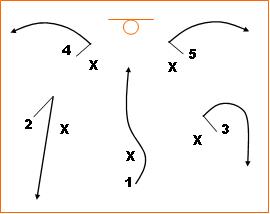
Getting Open is the act of getting away from a defender to get in a position to receive a pass from a teammate. Some methods include: The V-Cut, Jab step, Curling, and the “push off.”
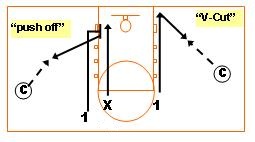
How is conditioning part of Offense?
10. Conditioning: A player can’t perform well consistently if they get tired easily. Conditioning is very important and should be part of every practice. If you don’t run your players in practice, don’t get mad at them when they aren’t hustling in the game.
Line Conditioning Drill (with Basketballs)
11. Setting Screens: We cannot forget the “screen” when talking about basketball offense. The screen is widely used but seldom taught at the younger ages. This is because it is a difficult skill to learn and execute. I have coached many older players that were never exposed to the basics of screens – teach the screen at all levels…
The “Screener” is an offensive player that intentionally gets in a position to “block” a defender from guarding another offensive player. To help put the player in a position to be “open.” Screening is very important when running a motion offense. Screens are also used in zone offenses and many other circumstances (inbounds plays, press breakers, etc).
Screening for the Shooter - Example
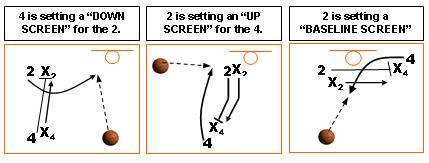
More information on Basic Screening
12. Attitude / Mental Skills: All the skill work in the world will not help a player that lacks in confidence. One of the worst situations that a coach can face is having players that are highly skilled, but are not using these skills in the game. A good shooter that has to be told to shoot, a post player that has to be told to box out (the list can go on and on).
Is there a solution for this? It takes a while for younger players to fix confidence problems. Coaches must remain positive and continue to encourage players in this situation. A coach should never, ever, try to “yell or scream” confidence into a player. Using ridicule doesn’t work either – this will only make the situation worse. Players need to be made aware of the “positive” results that can come from having more confidence. And coaches should try to practice situations where the player can gain confidence. My daughter entered a 3-point contest and was extremely scared to participate, but ended up winning. I can tell you that this one thing did wonders for building her confidence. It just takes a little time for some players.

Conclusion
Hopefully you get the bigger picture. There’s more to a basketball offense than just shooting the ball. A good offensive player must be able to shoot, pass, dribble, catch, rebound, use the triple threat position, use pass fakes, move off the dribble, screen, and have good hand quickness and footwork skills (understand the importance of youth basketball offense basics). As long as you work hard and do the drills correctly, you will improve. You must understand that it will take a lot of hard work over a long period of time to develop these skills. There’s no other way to make the process go faster. Most drills are not much fun for players, but that’s the reality of hard work and dedication.
Coaches should make every attempt to add a little fun and excitement to a drill. The more the players like the drill, the harder they will work at it. The skills gained through hard work are well worth the commitment.
Want more information on Basketball Offense? Try our new download publications…
Zone Offenses for Youth Basketball
and
Motion Offenses for Youth Basketball
Basketball Offense
Info on Offensive Schemes / Plays Here
